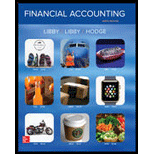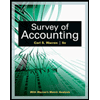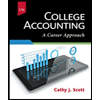
1 and 2
Prepare the T- account and enter the transaction into their respective accounts for calculating the ending balance.
1 and 2
Explanation of Solution
T-account:
T-account is the form of the ledger account, where the
The components of the T-account are as follows:
a) The title of the account
b) The left or debit side
c) The right or credit side
Prepare the T-accounts:
Cash account:
| Cash account | |||
| Beginning balance | $0 | (b) | $5,250 |
| (a) | $30,200 | (d) | $1,560 |
| (e) | $11,000 | (f) | $11,000 |
| (h) | $2,675 | (g) | $400 |
| (k) | $600 | (i) | $550 |
| (m) | $1,200 | (j) | $1,300 |
| (l) | $400 | ||
| Ending balance | $25,215 | ||
Accounts receivable account:
| Accounts receivable account | |||
| Beginning balance | $0 | (k) | $600 |
| (h) | $825 | ||
| Ending balance | $225 | ||
Supplies account:
| Supplies account | |||
| Beginning balance | $0 | ||
| (d) | $1,560 | ||
| Ending balance | $1,560 | ||
Inventory account:
| Inventory account | |||
| Beginning balance | 0 | (h) | $1,600 |
| (c) | $6,000 | (m) | $600 |
| Ending balance | $3,800 | ||
Prepaid expenses account:
| Prepaid expenses account | |||
| Beginning balance | $0 | ||
| (b) | $5,250 | ||
| Ending balance | $5,250 | ||
Equipment account:
| Equipment account | |||
| Beginning balance | $0 | ||
| (h) | $2,750 | ||
| Ending balance | $2,750 | ||
Furniture and fixtures account:
| Furniture and fixtures account | |||
| Beginning balance | $0 | ||
| (e) | $8,250 | ||
| Ending balance | $8,250 | ||
Accounts payable account:
| Accounts payable account | |||
| Beginning balance | 0 | ||
| (i) | $550 | (c) | $6,000 |
| Ending balance | $5,450 | ||
Notes payable account:
| Notes payable account | |||
| Beginning balance | $0 | ||
| (e) | $11,000 | ||
| Ending balance | $11,000 | ||
Common stock account:
| Common stock account | |||
| Beginning balance | $0 | ||
| (a) | $40 | ||
| Ending balance | $40 | ||
Additional paid-in capital account:
| Additional paid-in capital account | |||
| Beginning balance | $0 | ||
| (a) | 30,160 | ||
| Ending balance | $30,160 | ||
Cost of goods sold account:
| Cost of goods sold account | |||
| Beginning balance | $0 | ||
| (h) | $1,600 | ||
| (m) | $600 | ||
| Ending balance | $2,200 | ||
Repair expense account:
| Repair expense account | |||
| Beginning balance | $0 | ||
| (l) | $400 | ||
| Ending balance | $400 | ||
Sales revenue account:
| Sales revenue account | |||
| Beginning balance | 0 | ||
| (h) | $3,500 | ||
| (m) | $1,200 | ||
| Ending balance | $4,700 | ||
Advertising expense account:
| Advertising expense account | |||
| Beginning balance | 0 | ||
| (g) | $400 | ||
| Ending balance | $400 | ||
Wages expense account:
| Wages expense account | |||
| Beginning balance | 0 | ||
| (j) | $1,300 | ||
| Ending balance | $1,300 | ||
Thus, the t-accounts are prepared and the ending balances are calculated.
3.
Prepare an income statement for the month February.
3.
Explanation of Solution
Income statement:
The financial statement which reports revenues and expenses from business operations and the result of those operations as net income or net loss for a particular time period is referred to as income statement.
Prepare an income statement:
| Company KS | ||
| Income statement | ||
| For the month ended 28th February | ||
| Particulars | Amount ($) | Amount ($) |
| Revenues: | ||
| Sales revenue (1) | 4,700 | |
| Total revenues (A) | 4,700 | |
| Expenses: | ||
| Cost of goods sold (2) | 2,200 | |
| Advertising expense | 400 | |
| Wage expense | 1,300 | |
| Repair expense | 400 | |
| Total expenses (B) | 4,300 | |
| Net Income | $400 | |
Table (1)
Working note:
Calculate the total sales revenue:
Calculate the total cost of goods sold:
Hence, the net income of Company KS is $400.
4.
Write a memo to Person K regarding the results of operations during the first month of the business.
4.
Explanation of Solution
MEMO
From
XYZ
To
Person K
Company KS
28th February,
Sub: Results of operations during the first month of the business.
After the evaluation of effects of the transactions of Company KS, one can conclude that the company has earned a profit of $400. But, these are based upon unadjusted amounts. There are several expenses such as rent, supplies, depreciation, furniture and fixtures, interest on the borrowing and wages. The company does not seem to be profitable, as this situation is very common in small businesses during the inception of the operations. The company must focus on increasing revenues and while maintaining the expenses that should result in the upcoming years. The company should prepare budgeted
Regards,
XYZ
5.
Compute the net profit margin ratio for each year and explain the reason for promoting the manager.
5.
Explanation of Solution
Net profit margin ratio:
Net profit is the financial ratio that shows the relationship between the net profit and net sales (Operating revenue). Net profit is the difference between total operating revenue and total operating expenses. It can be calculated by dividing net profit and net sales revenue.
Compute the net profit margin ratio:
Net profit margin ratio for 2018:
Hence, the net profit margin ratio for the year 2018 is 0.235.
Net profit margin ratio for 2017:
Hence, the net profit margin ratio for the year 2017 is 0.133.
Net profit margin ratio for 2016:
Hence, the net profit margin ratio for the year 2016 is 0.080.
- By evaluating the net profit margin ratio, it is clear that the profit level of the Company has increased.
- This states that the company is very efficient in generating the revenue from the sales and controlling the expenses.
- Based on this the reasons, the company should promote its manager to the next level.
Want to see more full solutions like this?
Chapter 3 Solutions
Financial Accounting
- Please explain the solution to this general accounting problem with accurate principles.arrow_forwardHenderson Corporation uses the calendar year as its tax year. It acquires and places into service two depreciable assets during 2024: • Asset #1: 7-year property; $940,000 cost; placed into service on January 20. Asset #2: 5-year property; $410,000 cost; placed into service on August 1. View the MACRS half-year convention rates. Read the requirements. Calculate Henderson's depreciation deductions for 2024. (Use MACRS rates to two decimal places, X.XX%. Round the MACRS depreciation to the nearest dollar.) 2024 Depreciation Asset #1 Asset #2 Total depreciation 134,326 82,000 216,326 Calculate Henderson's depreciation deductions for 2025. (Use MACRS rates to two decimal places, X.XX%. Round the MACRS depreciation to the nearest dollar.) 2025 Depreciation Asset #1 Asset #2 Total depreciation 230,206 131,200 361,406 b. What are Henderson's depreciation deductions for 2024 and 2025 if this is the only property it places into service in those years and Henderson elects Sec. 179 expensing for…arrow_forwardCarlyon Company listed the following items in its December 31, Year 1, financial statements: Investment in Man Company bonds $21,000 Dividends payable: preferred 4,000 Dividends payable: common 50,000 Preferred stock, 8%, $100 par 100,000 Common stock, $10 par 500,000 Additional paid-in capital on preferred stock 20,000 Additional paid-in capital on common stock 262,500 Retained earnings 270,000 During Year 2, the following transactions occurred: Feb. 2 Paid the semiannual dividends declared on December 15, Year 1. Mar. 5 Declared a property dividend, payable to common shareholders on April 5 in Man Company bonds being held to maturity. The bonds (which have a book value of $21,000) have a current market value of $30,000. Apr. 5 Paid the property dividend. Jul. 6 Declared a $4 per share semiannual cash dividend on preferred stock and a $1.10 per share semiannual dividend on common stock, to be paid on August 17. Aug. 17 Paid the cash dividends.…arrow_forward
- Required information [The following information applies to the questions displayed below.] Jarvie loves to bike. In fact, he has always turned down better-paying jobs to work in bicycle shops where he gets an employee discount. At Jarvie's current shop, Bad Dog Cycles, each employee is allowed to purchase four bicycles a year at a discount. Bad Dog has an average gross profit percentage on bicycles of 25 percent. During the current year, Jarvie bought the following bikes: Description Retail Price Specialized road bike $ 4,000 Cost $ 3,600 Employee Price $ 2,800 Rocky Mountain mountain bike 5,000 4,100 4,000 Trek road bike 3,900 3,300 2,730 Yeti mountain bike 4,600 3,400 3,680 b. What amount of deductions is Bad Dog allowed to claim from these transactions? Amount of deductionsarrow_forwardJarvie loves to bike. In fact, he has always turned down better-paying jobs to work in bicycle shops where he gets an employee discount. At Jarvie's current shop, Bad Dog Cycles, each employee is allowed to purchase four bicycles a year at a discount. Bad Dog has an average gross profit percentage on bicycles of 25 percent. During the current year, Jarvie bought the following bikes: Description Retail Price Specialized road bike $ 4,000 Cost $ 3,600 Employee Price $ 2,800 Rocky Mountain mountain bike 5,000 4,100 4,000 Trek road bike 3,900 3,300 2,730 Yeti mountain bike 4,600 3,400 3,680 a. What amount is Jarvie required to include in taxable income from these purchases? Amount to be includedarrow_forwardYost received 300 NQOs (each option gives Yost the right to purchase 10 shares of Cutter Corporation stock for $19 per share). At the time he started working for Cutter Corporation three years ago, Cutter's stock price was $19 per share. Yost exercised all of his options when the share price was $38 per share. Two years after acquiring the shares, he sold them at $59 per share. Note: Input all amounts as positive values. Leave no answer blank. Enter zero if applicable. d. Assume that Yost's options were exercisable at $24 and expired after five years. If the stock only reached $22 during its high point during the five-year period, what are Yost's tax consequences on the grant date, the exercise date, and the date the shares are sold, assuming his ordinary marginal rate is 35 percent and his long-term capital gains rate is 15 percent? Grant date Exercise date Taxes Due Sale datearrow_forward
- Mark received 10 ISOs (each option gives him the right to purchase 14 shares of Hendricks Corporation stock for $6 per share) at the time he started working for Hendricks Corporation five years ago, when Hendricks's stock price was $5 per share. Now that Hendricks's share price is $35 per share, Mark intends to exercise all of his options and hold all of his shares for more than one year. Assume that more than a year after exercise, Mark sells the stock for $35 a share. Note: Enter all amounts as positive values. Leave no answers blank. Enter zero if applicable. b. What are Hendricks's tax consequences on the grant date, the exercise date, and the date Mark sells the shares? Grant date Exercise date Sale date Tax Benefitarrow_forwardYost received 300 NQOs (each option gives Yost the right to purchase 10 shares of Cutter Corporation stock for $19 per share). At the time he started working for Cutter Corporation three years ago, Cutter's stock price was $19 per share. Yost exercised all of his options when the share price was $38 per share. Two years after acquiring the shares, he sold them at $59 per share. Note: Input all amounts as positive values. Leave no answer blank. Enter zero if applicable. c. Assume that Yost is "cash poor" and needs to engage in a same-day sale in order to buy his shares. Due to his belief that the stock price is going to increase significantly, he wants to maintain as many shares as possible. How many shares must he sell in order to cover his purchase price and taxes payable on the exercise? Number of shares to be soldarrow_forwardMark received 10 ISOs (each option gives him the right to purchase 14 shares of Hendricks Corporation stock for $6 per share) at the time he started working for Hendricks Corporation five years ago, when Hendricks's stock price was $5 per share. Now that Hendricks's share price is $35 per share, Mark intends to exercise all of his options and hold all of his shares for more than one year. Assume that more than a year after exercise, Mark sells the stock for $35 a share. Note: Enter all amounts as positive values. Leave no answers blank. Enter zero if applicable. a. What are Mark's taxes due on the grant date, the exercise date, and the date he sells the shares, assuming his ordinary marginal rate is 32 percent and his long-term capital gains rate is 15 percent? Grant date Exercise date Sale date Taxes Duearrow_forward
- On January 1, year 1, Dave received 2,500 shares of restricted stock from his employer, RRK Corporation. On that date, the stock price was $13 per share. On receiving the restricted stock, Dave made the 83(b) election. Dave's restricted shares will vest at the end of year 2. He intends to hold the shares until the end of year 4, when he intends to sell them to help fund the purchase of a new home. Dave predicts the share price of RRK will be $33 per share when his shares vest and $54 per share when he sells them. Assume that Dave's price predictions are correct, and answer the following questions: Note: Leave no answers blank. Enter zero if applicable. Round your final answer to the nearest whole dollar value. Enter all amounts as positive values. b. What are the tax consequences of these transactions to RRK? Grant date Tax consequences Vesting date $ 0 Sale date $ 0arrow_forwardMeg works for Freedom Airlines in the accounts payable department. Meg and all other employees receive free flight benefits (for the employee, family, and 10 free buddy passes for friends per year) as part of its employee benefits package. If Meg uses 15 flights with a value of $6,975 this year, how much must she include in her compensation this year? Amount includedarrow_forwardSeiko's current salary is $101,000. Her marginal tax rate is 32 percent, and she fancies European sports cars. She purchases a new auto each year. Seiko is currently a manager for Idaho Office Supply. Her friend, knowing of her interest in sports cars, tells her about a manager position at the local BMW and Porsche dealer. The new position pays $84,600 per year, but it allows employees to purchase one new car per year at a discount of $19,400. This discount qualifies as a nontaxable fringe benefit. In an effort to keep Seiko as an employee, Idaho Office Supply offers her a $10,500 raise. Answer the following questions about this analysis. a. What is the annual after-tax cost to Idaho Office Supply if it provides Seiko with the $10,500 increase in salary? Note: Ignore payroll taxes. After-tax costarrow_forward
 College Accounting, Chapters 1-27AccountingISBN:9781337794756Author:HEINTZ, James A.Publisher:Cengage Learning,
College Accounting, Chapters 1-27AccountingISBN:9781337794756Author:HEINTZ, James A.Publisher:Cengage Learning, Survey of Accounting (Accounting I)AccountingISBN:9781305961883Author:Carl WarrenPublisher:Cengage LearningPrinciples of Accounting Volume 2AccountingISBN:9781947172609Author:OpenStaxPublisher:OpenStax College
Survey of Accounting (Accounting I)AccountingISBN:9781305961883Author:Carl WarrenPublisher:Cengage LearningPrinciples of Accounting Volume 2AccountingISBN:9781947172609Author:OpenStaxPublisher:OpenStax College- Century 21 Accounting Multicolumn JournalAccountingISBN:9781337679503Author:GilbertsonPublisher:Cengage
 College Accounting (Book Only): A Career ApproachAccountingISBN:9781337280570Author:Scott, Cathy J.Publisher:South-Western College Pub
College Accounting (Book Only): A Career ApproachAccountingISBN:9781337280570Author:Scott, Cathy J.Publisher:South-Western College Pub





